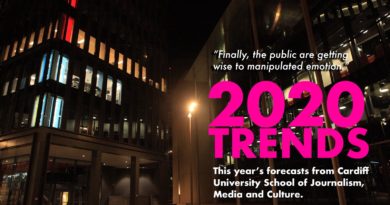Magazines and Media History
This post is by Tim Holmes
Marcus Morris founded The Eagle comic, still remembered for Dan Dare and cutaway illustrations of exciting mechanical artefacts like racing cars and jet aircraft. He followed this with Girl, Robin and Swift; he became the managing director of the National Magazine company, introducing Cosmopolitan to the UK; the British magazine industry’s most prestigious annual award is named in his honour – and Cardiff University has his personal archive!
I have worked at the university for 20-odd years and I had no idea this material was in our collections until last night, at the launch of the Tom Hopkinson Centre for Media History when head of the Special Collections & Archive section Alan Vaughan-Hughes revealed the riches available to researchers in the field of popular journalism.
Apart from Morris – a treasure trove for researchers and scholars in the field of Magazine Studies – Cardiff holds the archives of:
• Hugh Cudlipp – editor of the Mirror, chairman of IPC (one of the most significant magazine publishing houses in the UK)
• Joan Reeder – the first full time royal correspondent for a national newspaper
• Trevor Philpott – the Picture Post journalist-turned-broadcaster and onlie begetter of The Philpott File
• Keith Waterhouse – journalist, author, playwright, champagne drinker; this material is already being researched by Cardiff Magazine MA graduate and freelance journalist Will Ham Bevan for his PhD
• Richard Stott – editor of the Daily Mirror who stood up to Robert Maxwell
The Tom Hopkinson Centre for Media History aims to bring together “scholars, research students, journalists, photojournalists, documentary-makers, archivists, media activists and practitioners into an international, interdisciplinary network focusing on the evolution of media forms, practices, institutions and audiences within broader processes of societal change.” (Source)
It is also a great opportunity to push Magazine Studies further onto the research and scholarship radar, as launch guest and distinguished visiting fellow Professor John Hartley noted. Citing his own connection with the Welsh radical magazine Rebecca
In the 1970s and early 1980s Rebecca took the form of “a radical magazine for Wales” and gained a reputation as an investigative, campaigning title.
The magazine — and its uncompromising Corruption Supplement — documented the decay of Labour politics in south Wales and helped to bring about a long series of corruption trials which resulted in many politicians and businessmen going to prison.
Rebecca was also in the forefront of UK investigations into the relationship between the Labour Prime Minister James Callaghan and the Welsh multi-millionaire banker, Sir Julian Hodge.
Many Rebecca articles were reflected in coverage in newspapers like the Sunday Times and in television programmes including Man Alive, This Week and Nationwide. (Source)
and the historic example of The Clarion,
This cover illustration was drawn by Walter Crane, an associate of William Morris
Professor Hartley noted that social movements often brought with them their own kinds of journalism and studying the archive reveals many different types of journalism and different ways of producing and supporting journalism. The Clarion certainly had a widespread influence on many areas of social life – the National Clarion Cycling Club (motto: Fellowship through cycling) is still very active, as is the People’s Theatre in Newcastle. In an age when live events and brand extensions are becoming increasingly important sources of revenue, looking back to a time when they had a social and political purpose gives us a fresh perspective.
Other guests at the launch were Amanda Hopkinson, Sir Tom’s daughter and a distinguished scholar in her own right, and Magnum photographer David Hurn.
Dr Glenn Jordan, director of the Butetown History & Arts Centre, was in the audience for the launch. Glenn’s book Down The Bay
re-used Bert Hardy‘s photographs from Picture Post in a new context. I used it as the basis of a feature exercise for students on the PgDip (now MA) in Magazine Journalism for many years – it was a great way of introducing very nice middle class students to the past and present of a genuinely multicultural working class area of Cardiff and a lesson in how to use photographs creatively but for a purpose.



